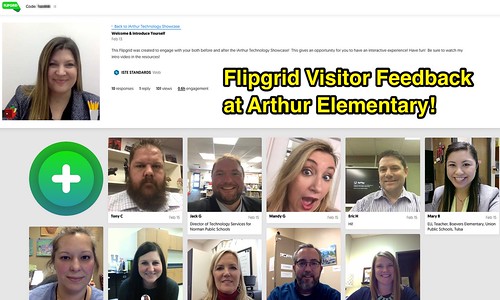Arthur Elementary School (@Arthurokcps) in Oklahoma City Public Schools (@okcps) is one of just 114 schools nationwide participating in Apple’s ConnectED program. Every teacher and student at Arthur Elementary has an iPad tablet computer. This is the third year of the project, and yesterday teachers, students and administrators hosted an open house at Arthur to showcase how iPads are becoming part of “normal classroom routines” to help students learn, grow, and become contributing members of our Oklahoma City community. Dr. Rhonda Schroeder (@rhondaschroeder) is the principal at Arthur Elementary, and her leadership as well as vision for learning is a key ingredient in the successful story of twenty-first century education which continues to unfold at Arthur.
#OklaEd If your schedule permits, RSVP to attend the @OKCPS Arthur Elementary ConnectED Grant Showcase this Thursday, Feb 15th from 12:30 – 3 pm! @rhondaschroeder and teachers at Arthur are in year 3 of their iPad 1:1 project & will share lessons learned! https://t.co/KhaCmNYpUO
— Wesley Fryer ??? (@wfryer) February 12, 2018
After a brief welcome from Dr. Schroeder, all the visitors yesterday to Arthur Elementary were invited to explore the building and see student learning in action in different classrooms! Here are some of the highlights from my visit and observations.
Different Digital Ways to Show What Students Know
When I visited Mrs. Powell’s third grade classroom, students were presenting video projects they recently finished about the life cycle of plants. I watched three student presentations, and while each student had used the iMovie for iOS app to create their project, each student made their project in a different way to “show what they know.” I love this! Encouraging and supporting students to “show what they know with media” is a key ingredient of effective and ENGAGING digital learning. Using iMovie for iOS, each third grader explained the plant life cycle in a different way:
- By creating a narrated slideshow
- By recording “selfie-video” clips explaining the steps in the cycle, and following up each clip with a photo of that plant growth stage
- By creating “an iMovie Trailer” of the key stages of the cycle
After each student presented their project to the class, wirelessly mirroring their iPad screen to a classroom projector using an AppleTV, fellow students used Google Classroom to quickly access a teacher-created, online feedback form. They used that Google Form to provide feedback to each classmate via several multiple choice questions as well as an open answer feedback question. This is a technique I used back in 2011 teaching the “Technology for Teachers” course for undergraduates at the University of Central Oklahoma, and it was wonderful to see third graders in OKCPS using the same feedback strategy yesterday!
Hands-on Learning Was Everywhere
High quality learning experiences are not defined by access to technology, but rather by the high level of engagement shown by students. In line with this philosophy, I saw multiple classrooms of students and teachers at Arthur Elementary yesterday engaged in hands-on learning! First grade students were conducting experiments using colored water, plastic syringes and tubes, learning about air pressure and volume. Other students were making floam (foam and slime) in a classroom center, while other students at other centers were using the iPad app Toontastic to create and read their own animated cartoons.
.@mralberto_jh I loved ?? visiting your wonderful @arthurOKCPS @okcps classroom today and learning about @StoryBots from your kindergarten students! Thanks for letting us peek into your learning today! #oklaed pic.twitter.com/D4x1Y6sFqq
— Wesley Fryer ??? (@wfryer) February 15, 2018
Seesaw Learning Journals and QR Codes Making Student Digital Work Accessible
The engagement of students at Arthur Elementary in their learning with digital tools was not only visible in their classrooms, it was also visible everywhere in the hallways of the school! I loved seeing photos and QR code links to student projects using Seesaw. Seesaw is a platform for student learning journals, which we have been using at our school the past three years. I believe Seesaw is one of the most powerful digital tools available today for engaging parents, students and teachers in deeper conversations about learning both inside and outside the classroom. It was great to see Seesaw, as well as Google Classroom, in use by students and teachers at Arthur. It was also great to see QR code links to student project videos using Google Drive. I used the i-Nigma app on my iPad to scan some of these QR Codes. One of the student projects I watched was an iMovie trailer video about the history of the Comanche Tribe. Again, it warmed my heart to not only see how students are using images, video and text to create media-rich representations of their learning at Arthur Elementary, but also to see how these digital creations are being shared directly with parents (via Seesaw) as well as the school community walking the hallways of the school.
Flipgrid Videos Used for Visitor Feedback
One of the very progressive uses of technology I saw and experienced at Arthur Elementary yesterday involved the use of Flipgrid. Arthur Elementary teachers and administrators created some Flipgrids in advance of the open house, and posted QR codes outside classrooms and in provided handouts to visitors. Visitors were invited to not only introduce themselves, but also provide specific feedback to the students and teachers whose classrooms they observed. This was great! This is a feedback strategy for educators in other schools to keep in mind and possibly copy for similar open house events.

“Flipgrid Feedback at Arthur Elementary” (CC BY 2.0) by Wesley Fryer
More Oklahomans Need to Know About Learning Innovation at Arthur Elementary!
I was very inspired to spend time with the students and teachers at Arthur Elementary, and walked away wanting even more Oklahomans (as well as others outside our state) to know about the innovative as well as courageous learning happening within the walls of Arthur! Change is difficult, but it is clear from a brief visit to Arthur Elementary that the educators as well as students there are embracing the positive opportunities which digital tools can provide.
Thank you, Arthur teachers and students, for opening your classrooms to our wider community yesterday! You inspired and challenged us all to think about the ways we can stretch and grow to make classroom learning in 2018 even more engaging and meaningful for everyone!
What a wonderful peek into iPad powered learning at @arthurOKCPS today! Fantastic job @rhondaschroeder, teachers & students! #iArthur is a gem ? in @okcps #oklaed & the nation! Woo hoo @apple & #ConnectEd grant facilitators – and @Seesaw learning journals! pic.twitter.com/sTh25BNsOV
— Wesley Fryer ??? (@wfryer) February 15, 2018
If you enjoyed this post and found it useful, consider subscribing to Wes’ free, weekly newsletter. Generally Wes shares a new edition on Monday mornings, and it includes a TIP, a TOOL, a TEXT (article to read) and a TUTORIAL video. You can also check out past editions of Wes’ newsletter online free!
Did you know Wes has published several eBooks and “eBook singles?” 1 of them is available free! Check them out! Also visit Wes’ subscription-based tutorial VIDEO library supporting technology integrating teachers worldwide!
MORE WAYS TO LEARN WITH WES: Do you use a smartphone or tablet? Subscribe to Wes’ free magazine “iReading” on Flipboard! Follow Dr. Wesley Fryer on Twitter (@wfryer), Facebook and Google+. Also “like” Wes’ Facebook page for “Speed of Creativity Learning”. Don’t miss Wesley’s latest technology integration project, “Show With Media: What Do You Want to CREATE Today?”
Source : Inspired by Innovative OKCPS Teachers and Students at Arthur Elementary School










